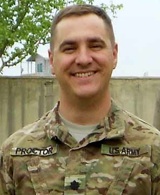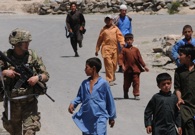Report from Afghanistan – A Continuing Series of First-Person Accounts
Before deploying to Afghanistan with the U.S. 1st Infantry Division in the spring of 2012, Lieutenant Colonel Pat Proctor agreed to send Armchair General a series of “Reports from Afghanistan.” Proctor’s reports will share with our readers his and the division’s experiences during their deployment, giving ACG readers a unique “boots on the ground” perspective. The first report in this series provides an overview of the situation today in Afghanistan and sets the stage for his upcoming future reports, which will be linked from this page as they are received.
 Report from Afghanistan 1: One Enemy, Many Faces
Report from Afghanistan 1: One Enemy, Many Faces
As the U.S. 1st Infantry Division, the storied “Big Red One,” takes charge of Regional Command-East (RC-East) – an area the size of Pennsylvania surrounding the capital province of Kabul, with an ethnically diverse population of 7 to10 million Afghans – it does so at a challenging time. American public support for the war is at an all-time low and the U.S. force is in the midst of a drawdown that will see its numbers cut by nearly a third (to 68,000) by the end of the year. The 1st Infantry Division also takes charge in a very challenging environment, beset by a variety of enemy groups with often contradictory aims. Click the title to read the full report.
 Report from Afghanistan: A Turning Tide?
Report from Afghanistan: A Turning Tide?
The Pashtun ethnic group is the largest ethnic group in Afghanistan and the population currently beset by the Taliban insurgency. It is also widely considered the world’s largest tribal ethnic group. Yet, Pashtun tribal leadership has been decimated by three decades of war, destroying any sense of solidarity or cohesion beyond the village level. In the absence of a broader unifying identity, many Pashtuns have turned to the Taliban insurgency. Others, however, have turned to their tamim, the factions with whom they fought during the Soviet-Afghan war or the subsequent Afghan civil war. Among the largest of these is the Hezb-e-Islami (literally "Party of Islam"). Click on the title to read the full report.
 The Frontier of Freedom
The Frontier of Freedom
Forward Operating Base (FOB) Bostick, in the rugged mountains of northern Kunar Province, is the frontline of a war without frontlines. Every day, Task Force Red Warrior (1st Battalion, 12th Infantry) is locked in a pitched battle with insurgents to extend the reach of Afghan national security forces into this remote land. Every week they add to the long list of insurgents killed or captured in northern Kunar. Yet, Lt. Col. Scott Green, the Red Warrior’s commander, would be the first to say that this isn’t enough. With the U.S. set to leave at the end of 2014, his most important job is not killing insurgents, but preparing the Afghans to continue the fight without him. Click on the title to read the full report.
 The Battle for Kunar
The Battle for Kunar
More than any place in eastern Afghanistan, Kunar province illustrates the difficulty of handing the fight over to Afghan national security forces while the war still rages. Across the province, a patchwork of U.S. and Afghan security forces are serving: Task Force Mountain Warrior (4th Brigade, 4th Infantry Division), security force assistance advisor teams (SFAATs) from Strike Brigade (2d Brigade, 101st Airborne Division), two battalions of 2d Brigade, 201st Afghan National Army (ANA) Corps, three battalions of the Afghan Border Patrol, and hundreds of Afghan uniformed police. They struggle to hold the cities and villages along the narrow Kunar River valley against the constant pressure of Afghan and Pakistani Taliban insurgents who flow back and forth across the porous border with Pakistan through countless mountain passes along Kunar’s eastern border. Click on the title to read the full report.

